CLAS242 - The Trajan and Hadrian Period
1/33
Earn XP
Description and Tags
Name | Mastery | Learn | Test | Matching | Spaced |
|---|
No study sessions yet.
34 Terms
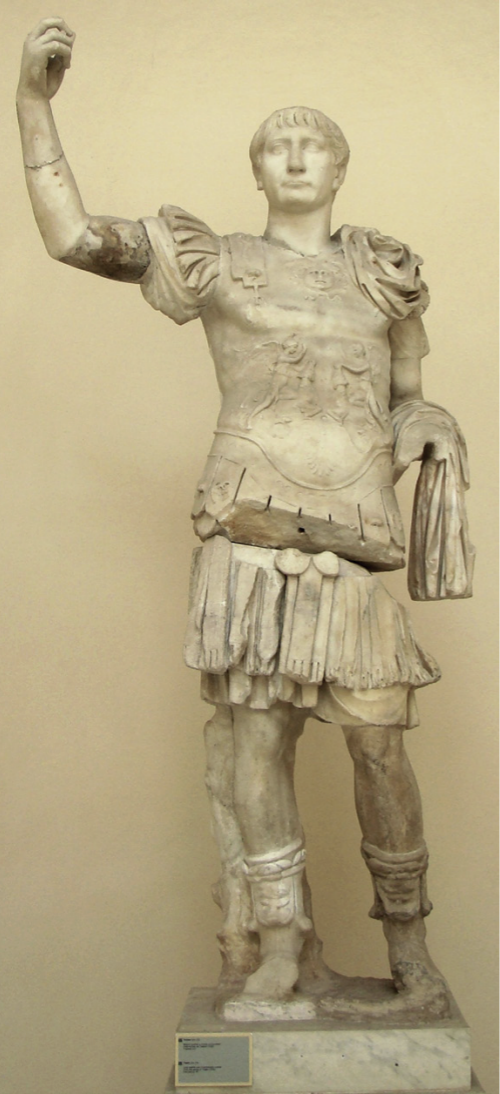
Identify and Analyze
Portrait of Trajan as victorious general, Ostia
The Trajan and Hadrian Period
98 CE - 138 CE
Next Emperor
after Nerva, no familial relation
weak and old ruler with no heirs
Praetorian Guard angered by Domitian’s assassination
only ruled less than 16 months - not much art contributed by him
new idea for emperors: pick who they think is best to be the next emperor without the need of family ties
Role Portraiture
general, was successful as one
number of victorious wars
always showed himself as this
maybe because Hadrian wasn’t a general
Return to Classicism
distancing from Flavian’s Verism just as they had done verism to distance themselves from the Julio-Claudians
Roman Iconography
traditional Roman victory imagery
cuirass
military cloak on left shoulder
Greek Iconography
flying pair Victories on his breastplate
can be traced back to reliefs on Acropolis
variation of Contrapposto
Augustus Similarities
last emperor who greatly expanded Roman territory
Agelessness
Augustus - eternally youthful
Trajan - eternally like 45 (when he became Emperor)
Acts as Emperor
first major
withdrawing roman forces from the Parthian teritories
they were invaded/occupied but never stabilized
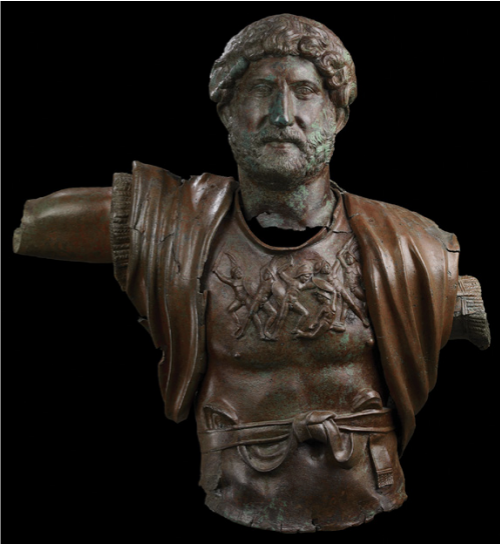
Identify and Analyze
Bronze cuirassed portrait of Hadrian, near Tel Shalem, Israel
The Trajan and Hadrian Period
98 CE - 138 CE
Next Emperor
after Trajan
Beard
first emperor to be depicted with one, otherwise they were usually clean shaven
usually only barbarians/lower Roman classes had one
Two Reasons:
as a youth, he was known to have horrible acne
a beard to hide the scars
Philhelene
“lover of Greek”
not only art but the culture too
would write poetry/plays/etc in Greek styles
a style that all following emperors for the next 100 years followed
Philhelene Acts
spent lots on a bunch of Greek things
most architecture/art that survives in Athens is Hadrianic
and other places he went to as well, he would just give a bunch of money to fix everything up that had fallen/was falling to ruins
Cuirass/Breastplate
mythological battle
Greek Thing
rare to present mythological battles over historical ones in Roman culture
Aeneid, Trojan War
because of Aeneas being the founder of Rome
Hair
curly - Greek thing
could be from a curling iron
Portraiture Innovation
drilled irises into eyeballs
helped expression and depth/can paint
only post-Hadrianic
Eternally presented as the age he was when he was crowned emperor
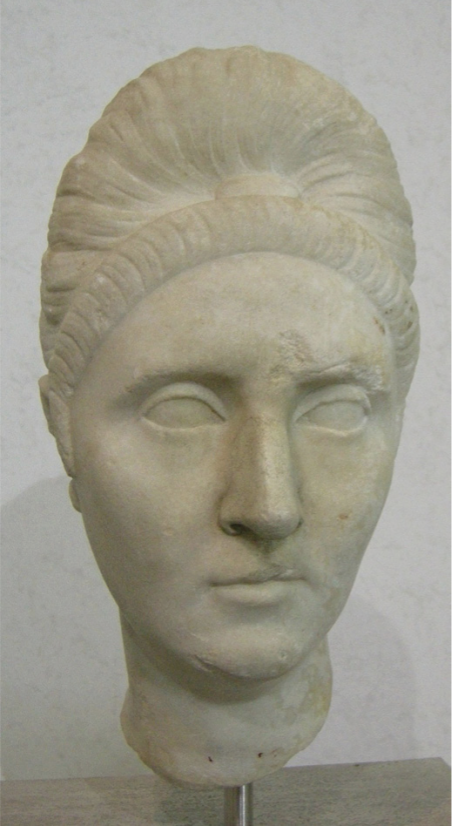
Identify and Analyze
Portrait of Plotina, wife of Trajan, from Maritime Baths, Ostia
The Trajan and Hadrian Period
98 CE - 138 CE
Plotina
Trajan’s Wife
Classical Look
some changes
no longer as Goddess-like
simplified beehive
no elaborate curls
maybe even just a more modest look
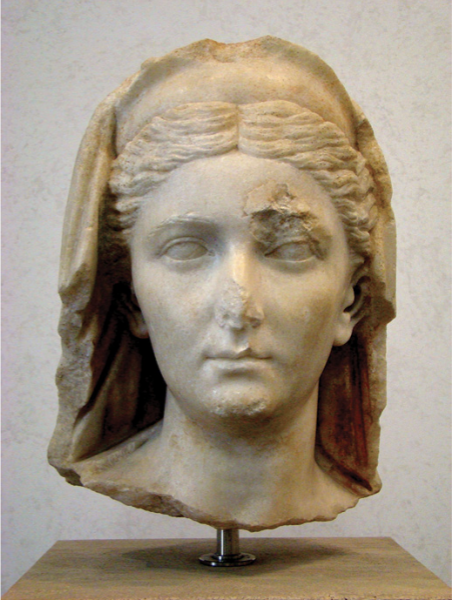
Identify and Analyze
Portrait of Sabina, wife of Hadrian, from Maritime Baths, Ostia
The Trajan and Hadrian Period
98 CE - 138 CE
Sabina
Hadrian’s wife
Classical Look
heavy return to Greek Goddess look
hair pulled into loose bun at back
middle part
diadem
tiara and veil
probably based on Venus
other portraits of her include symbols of Juno or Ceres
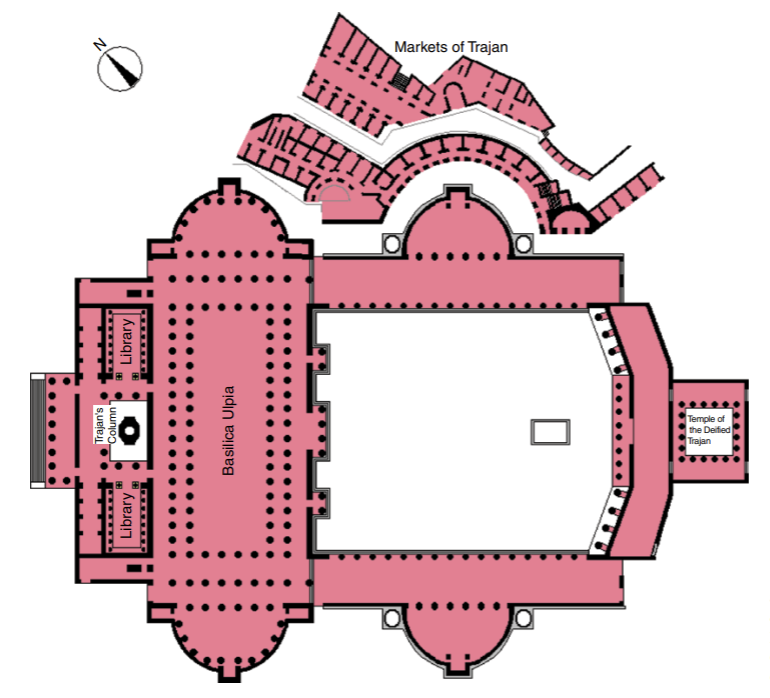
Identify and Analyze
Plan of the Forum of Trajan (Forum Traiani), Rome
The Trajan and Hadrian Period
98 CE - 138 CE
Forum Traiani
fifth, largest, and final of the imperial fora (forums)
Like Julius Caesar
separate forum off to Roman Forum
means as gifts to the Romans as things for them to do with their spare time
Temple to Divine Trajan
an Emperor can now be worshipped as a god during their lifetime
worshipped as God + Emperor at the same time
Meeting Place
a place to get out of the sun
bumped off semi circulars with sculptures inside
entered through the basilica
Basilica Ulpia
2 Big Public Libraries
first eveidence of large scale public libraries
some smaller ones existed, but one needed to be literate in order to even have it be of use to them
bigger ones existed but truly only private ones for nobles/upper class
one fully in Greek, the other in Latin
Column of Trajan
in the middle of the two libraries
Pillars up Top
many relief sculptures of many Trajan victories in battles
Rome was the best under Trajan
best economy, highest area of land
Decoration
whole theme is Trajan’s victory for the Dacians
which basically paid for the construction of the building because Rome became so rich off of the spoils
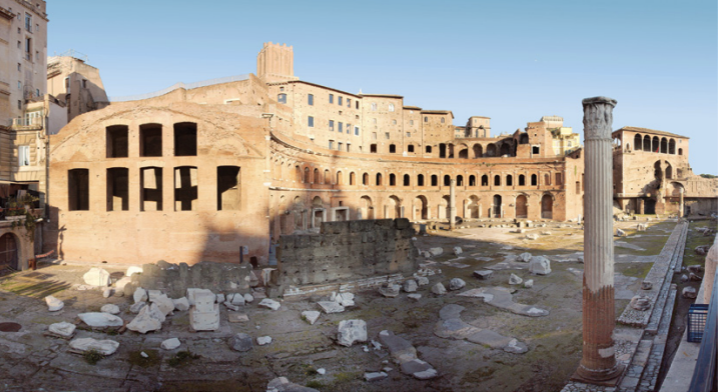
Identify and Analyze
Markets of Trajan designed by Apollodorus of Damascus
The Trajan and Hadrian Period
98 CE - 138 CE
Stalls for shops, like a mall
over 150 individual shops/offices
Quirinal Hill
shops extend six stories up the side of it
Light source?
difficult with no artifical lighting
half the available light gone because half the building it against a cliff
Hemicycle
creates longer building than a straight design
lower floor then serves as foundation for upper levels
Apollodorus of Damascus
celebrated architect
combination of what concrete can do
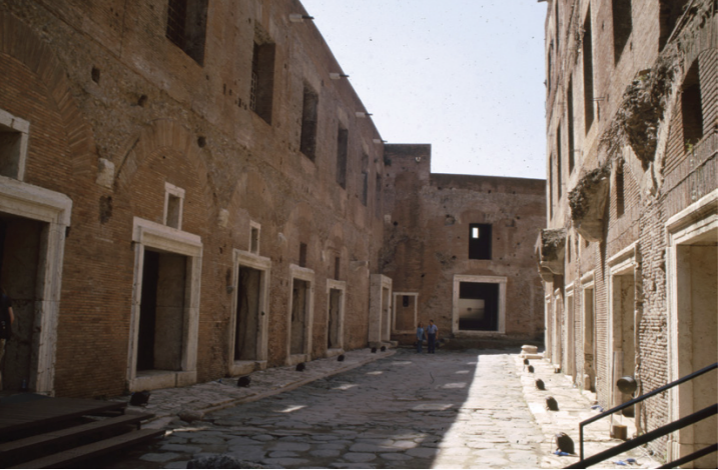
Identify and Analyze
Street of shops, Markets of Trajan designed by Apollodorus of Damascus, Rome
The Trajan and Hadrian Period
98 CE - 138 CE
each shop had an open door
vaulted roof and form of a skylight to bring it light to interior spaces//passageways/stairs
Upper Floors
a step back from lower ones to bring in this light
Apollodorus of Damascus
celebrated architect
combination of what concrete can do
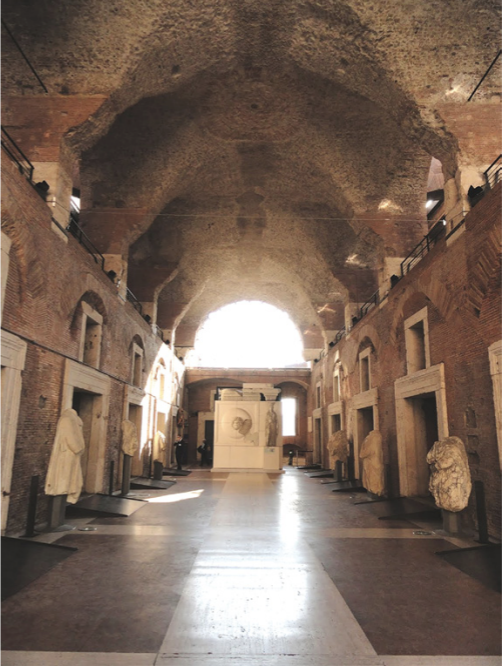
Identify and Analyze
Main Hall, Markets of Trajan designed by Apollodorus of Damascus
The Trajan and Hadrian Period
98 CE - 138 CE
Main Hall
over 91 feet long
two stories
six shops on each level/on each side of the hall
Groin Vaults
gives the market impression of being tall + airy
Apollodorus of Damascus
celebrated architect
combination of what concrete can do
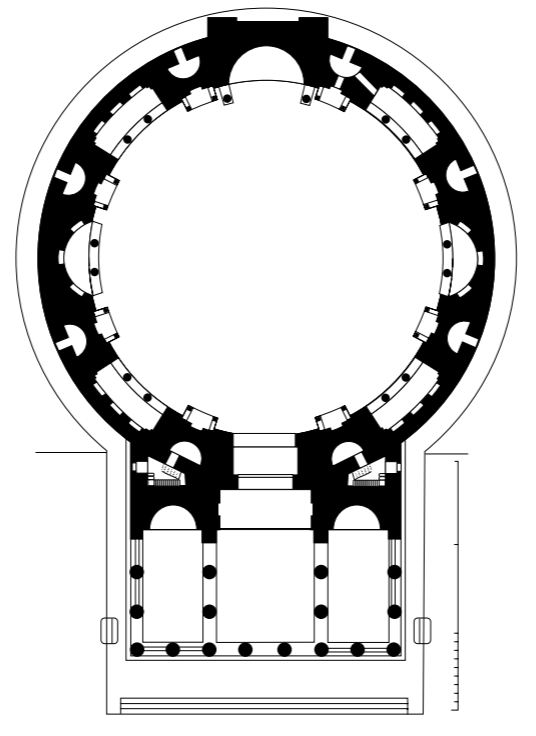
Identify and Analyze (two images)
Pantheon, Rome, plan and section
The Trajan and Hadrian Period
98 CE - 138 CE
Pantheon
Greek - pan - all; theon - building of the gods
a place to worship any god
but really only the Olympians
nothing known of the cult activities that occurred within
Existed Prior to Hadrian
later destroyed and then Hadrian provided the funds to rebuild it
Best preserved surviving Roman temple
Front
Greek Temple style
deep porch
corinthian pillars
Inscription
“Marcus Agrippa, son of Lucius, consul for the third time, made this”
Marcus Agrippa was the original one to make the Parthenon
Hadrian kept the inscription
maybe because he loved architecture/had an appreciation for Agrippa’s work
or he wanted to be associated with the old emperors/Julio-Claudian bloodline
True Arched Dome - Rotunda
concrete
laid in a single batch
biggest built until Michelangelo
though still the largest diameter dome of unreinforced concrete
Coiffures
structural reason - makes the concrete lighter and cuts away some of the weight to improve structural integrity
perfect sphere
Niches
statues for the Gods
Oculus
let in light
rain?
the floor was slightly sloped with drains at the edges of the interior for the water to disperse
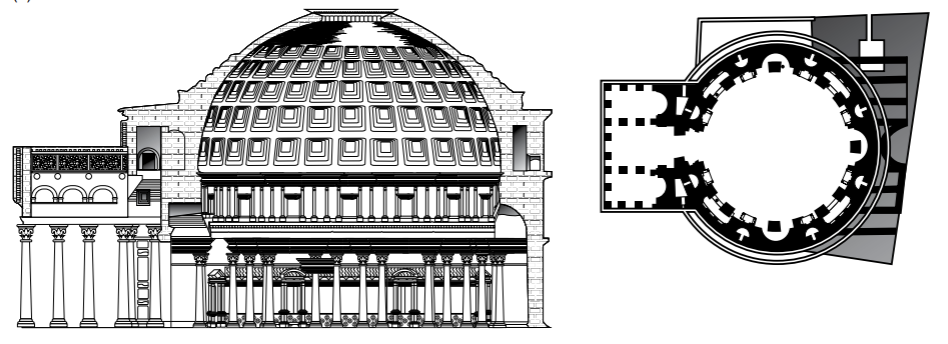

Identify and Analyze
Facade on the Pantheon, Rome
The Trajan and Hadrian Period
98 CE - 138 CE
Pantheon
Greek - pan - all; theon - building of the gods
a place to worship any god
but really only the Olympians
nothing known of the cult activities that occurred within
Existed Prior to Hadrian
later destroyed and then Hadrian provided the funds to rebuild it
Best preserved surviving Roman temple
Front
Greek Temple style
deep porch
corinthian pillars
Inscription
“Marcus Agrippa, son of Lucius, consul for the third time, made this”
Marcus Agrippa was the original one to make the Parthenon
Hadrian kept the inscription
maybe because he loved architecture/had an appreciation for Agrippa’s work
or he wanted to be associated with the old emperors/Julio-Claudian bloodline
True Arched Dome - Rotunda
concrete
laid in a single batch
biggest built until Michelangelo
though still the largest diameter dome of unreinforced concrete
Coiffures
structural reason - makes the concrete lighter and cuts away some of the weight to improve structural integrity
perfect sphere
Niches
statues for the Gods
Oculus
let in light
rain?
the floor was slightly sloped with drains at the edges of the interior for the water to disperse
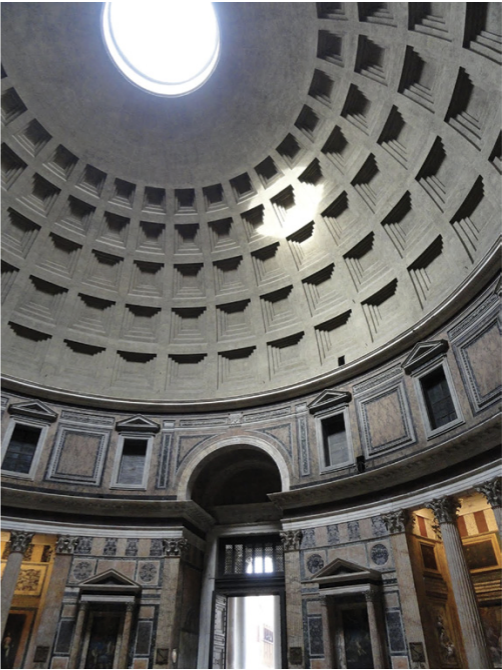
Identify and Analyze
Interior of the Pantheon, Rome
The Trajan and Hadrian Period
98 CE - 138 CE
Pantheon
Greek - pan - all; theon - building of the gods
a place to worship any god
but really only the Olympians
nothing known of the cult activities that occurred within
Existed Prior to Hadrian
later destroyed and then Hadrian provided the funds to rebuild it
Best preserved surviving Roman temple
Front
Greek Temple style
deep porch
corinthian pillars
Inscription
“Marcus Agrippa, son of Lucius, consul for the third time, made this”
Marcus Agrippa was the original one to make the Parthenon
Hadrian kept the inscription
maybe because he loved architecture/had an appreciation for Agrippa’s work
or he wanted to be associated with the old emperors/Julio-Claudian bloodline
True Arched Dome - Rotunda
concrete
laid in a single batch
biggest built until Michelangelo
though still the largest diameter dome of unreinforced concrete
Coiffures
structural reason - makes the concrete lighter and cuts away some of the weight to improve structural integrity
perfect sphere
Niches
statues for the Gods
Oculus
let in light
rain?
the floor was slightly sloped with drains at the edges of the interior for the water to disperse
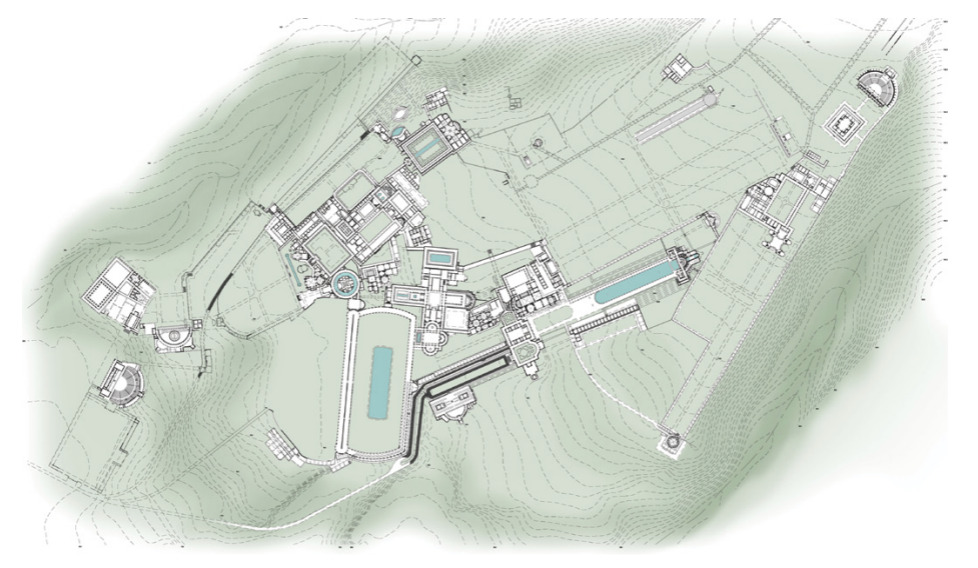
Identify and Analyze
Plan of the Villa of Hadrian, Tivoli, Hadrianic
The Trajan and Hadrian Period
98 CE - 138 CE
Greek + Egyptian + Roman architecture
Lots of Brickwork and Concrete
Includes the Circular Island Suite
Almost like a laboratory where he experiemnted in concrete and radical roofing systems
Many complexly designed buildings
Largest imperial villa in the Roman world
stretched around 17 miles
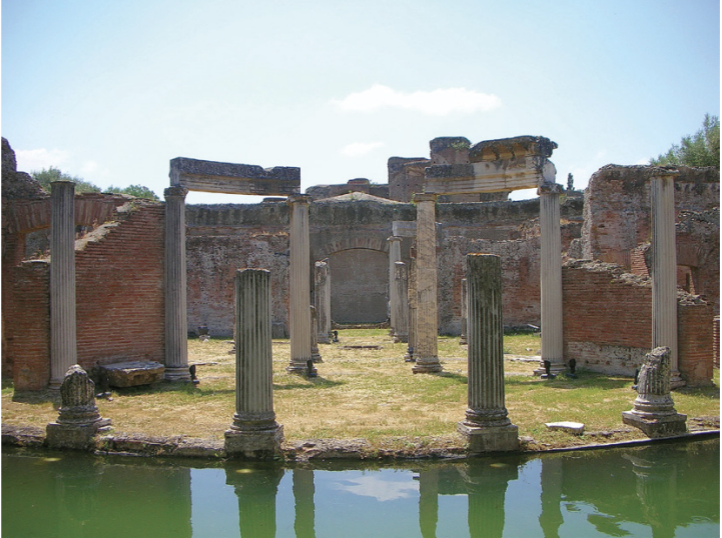
Identify and Analyze
Circular Island Suite, Villa of Hadrian, Tivoli, Hadrianic
The Trajan and Hadrian Period
98 CE - 138 CE
Teatro Marittimo
people gathered in and hung out
specific purpose unknown
suspected to be Hadrian and Sabina’s private apartment suite
or astronomical observatory
Water Features
Played on Aquatic themes
mythological or realistic
Hellenic Forms
heavy influence
sense of theatre/dramatics brought to a personal open space
Imitation River
Canopus
named after a canal at Alexandria in Egypt
ran between the Nile and the sanctuary of Serapis
drains and semi circular benches
as a dining area
View down the entire fake river
imitating the Nile
Egyptian style
Niches
statues
Mars, Mercury, and Minerva
Scylla
last scene in Tiberius’ dining grotto
mimicking elements of that?
4 copies of Caryatids from Acropolis
Imitation Dome
Melon Dome
not perfect sphere/real dome
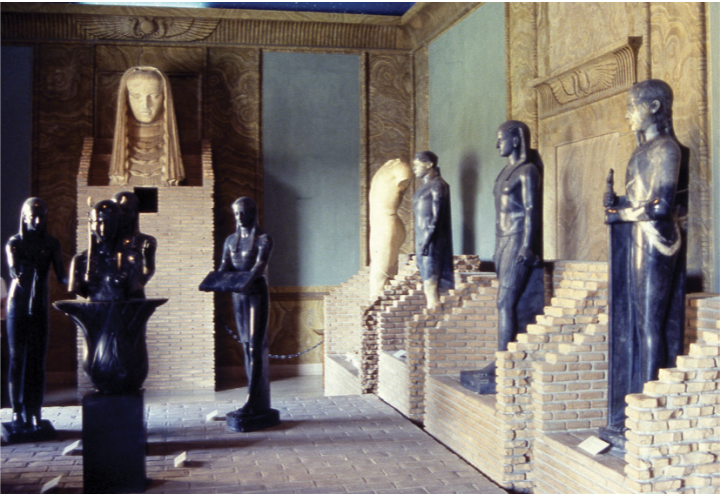
Identify and Analyze
Sculpture from the Serapeum complex, Villa of Hadrian, Tivoli, Hadrianic
The Trajan and Hadrian Period
98 CE - 138 CE
Temple of Serapus
Egyptian + Greek
Popularity of Egyptian culture/religion after it was conquered
Serapus - invention by the Greeks
all the Egyptian Gods + some Greek ones that were all combined into one
Black Statues
mimicking Egyptian black salt stone
Romans used black limestone
Egyptian Headresses/Decoration
winged sphinx
Big Head
Serapus
but - it’s Antinous
Antinous
16 - 18 year old Greek boy
famous for being gorgeous
idea that good looks reflects a good insides/soul
Hadrian travelling all the time, met Antinous and caught his attention
Became Hadrian’s lover; known to be passionate relationship
open display of a young male lover a very Greek thing
Hadrian brought him everywhere with him and his wife
Sabina was pretty much unbothered by the whole thing
Trip to the Nile
Antinous falls into the Nile and drowns
story uncertain of how it truly happened/how he fell off the boat
Hadrian was heartbroken and deified him
only non-imperial to be deified
Cult of Antinous
spread under Hadrian
as a living embodiment of beauty
bajillion images of him throughout the empire
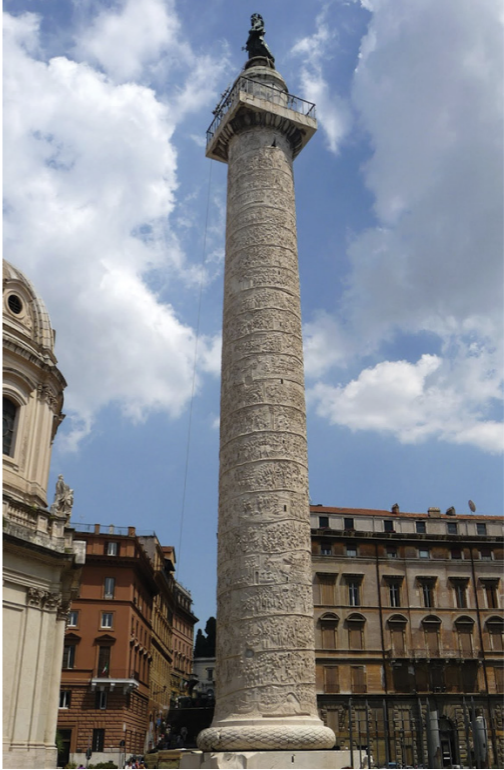
Identify and Analyze
Column of Trajan, Rome, dedicated 113 CE
The Trajan and Hadrian Period
98 CE - 138 CE
within the heart of the Trajan Forum
Meant to commemorate the amount of work that went into the forum
height of the column was the same as the amount of dirt that was taken away from the area during construction
Trajan’s Victory in Dacia
Trajan’s and Plotina’s ashes in base
not originally meant to be a tomb
column was so famous that Hadrian and the senate voting on putting them there
3 Parts
Base
door inside to stairs that lead up to the top
Column
stairs inside
decked out with relief sculpture
separate drums attached together
if broken, the whole column wouldn’t be garbage, they could just replace a single part
Top
statue of Trajan on horseback
now gone
Modern adaptation
statue of Saint Peter placed in 16th century
part of the column was partly buried for a while but it was always visible
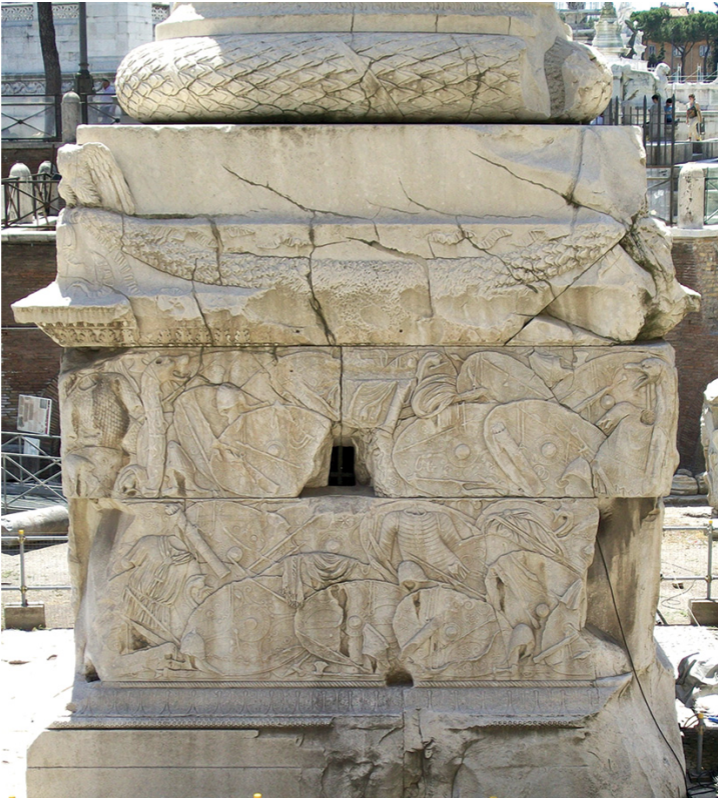
Identify and Analyze
Base of the Column of Trajan, Rome, dedicated 113 CE
The Trajan and Hadrian Period
98 CE - 138 CE
within the heart of the Trajan Forum
Meant to commemorate the amount of work that went into the forum
height of the column was the same as the amount of dirt that was taken away from the area during construction
Trajan’s Victory in Dacia
Trajan’s and Plotina’s ashes in base
not originally meant to be a tomb
column was so famous that Hadrian and the senate voting on putting them there
3 Parts
Base
door inside to stairs that lead up to the top
Column
stairs inside
decked out with relief sculpture
separate drums attached together
if broken, the whole column wouldn’t be garbage, they could just replace a single part
Top
statue of Trajan on horseback
now gone
Modern adaptation
statue of Saint Peter placed in 16th century
part of the column was partly buried for a while but it was always visible
Relief Sculpture
Captive Armor + People
Celtic People imagery
oblong shield
“screaming duck” - celtic horn
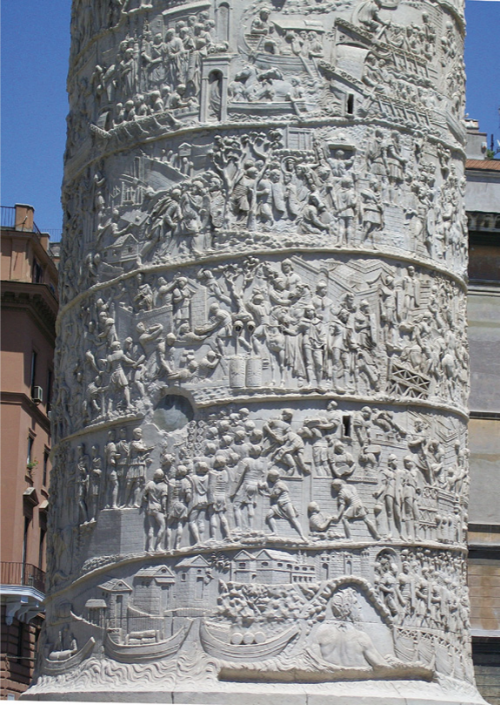
Identify and Analyze
Spiral frieze of the Column of Trajan, Rome, dedicated 113 CE
The Trajan and Hadrian Period
98 CE - 138 CE
within the heart of the Trajan Forum
Meant to commemorate the amount of work that went into the forum
height of the column was the same as the amount of dirt that was taken away from the area during construction
Trajan’s Victory in Dacia
Trajan’s and Plotina’s ashes in base
not originally meant to be a tomb
column was so famous that Hadrian and the senate voting on putting them there
3 Parts
Base
door inside to stairs that lead up to the top
Column
stairs inside
decked out with relief sculpture
separate drums attached together
if broken, the whole column wouldn’t be garbage, they could just replace a single part
Top
statue of Trajan on horseback
now gone
Modern adaptation
statue of Saint Peter placed in 16th century
part of the column was partly buried for a while but it was always visible
Relief Sculpture - Bottom of spiral frieze
wonder work of Roman historic narrative
Romans crossing Danube river to Dacia
Danube is represented by the personification of it here
One of Trajan’s feats: building the bridge across the Danube to invade Dacia
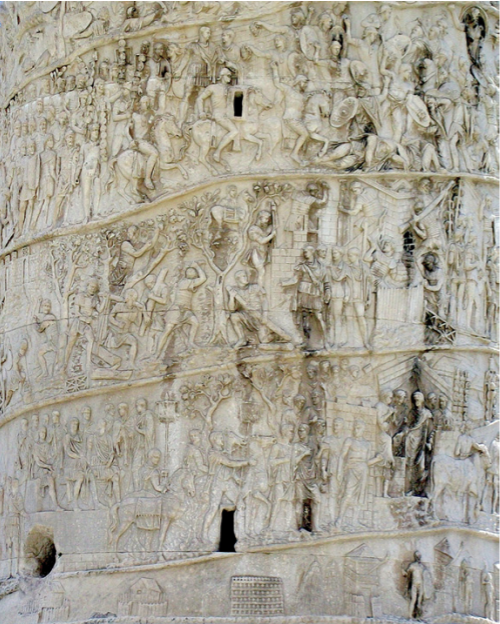
Identify and Analyze
Spiral frieze of the Column of Trajan, lower registers, Rome, dedicated 113 CE
The Trajan and Hadrian Period
98 CE - 138 CE
within the heart of the Trajan Forum
Meant to commemorate the amount of work that went into the forum
height of the column was the same as the amount of dirt that was taken away from the area during construction
Trajan’s Victory in Dacia
Trajan’s and Plotina’s ashes in base
not originally meant to be a tomb
column was so famous that Hadrian and the senate voting on putting them there
3 Parts
Base
door inside to stairs that lead up to the top
Column
stairs inside
decked out with relief sculpture
separate drums attached together
if broken, the whole column wouldn’t be garbage, they could just replace a single part
Top
statue of Trajan on horseback
now gone
Modern adaptation
statue of Saint Peter placed in 16th century
part of the column was partly buried for a while but it was always visible
Relief Sculpture - Upper pats of spiral frieze
Climbing through different battles
historical sequence
Trajan appearing multiple times throughout
some Italic elements
scale doesn’t matter
mainly classical
body proportions
decorative elements
strategic placement to show where one scene ends and another begins

Identify and Analyze
Trajan in battle, Great Trajanic Frieze, from the Forum of Trajan, Rome, Trajanic
The Trajan and Hadrian Period
98 CE - 138 CE
within the heart of the Trajan Forum
Meant to commemorate the amount of work that went into the forum
height of the column was the same as the amount of dirt that was taken away from the area during construction
Trajan’s Victory in Dacia
Trajan’s and Plotina’s ashes in base
not originally meant to be a tomb
column was so famous that Hadrian and the senate voting on putting them there
3 Parts
Base
door inside to stairs that lead up to the top
Column
stairs inside
decked out with relief sculpture
separate drums attached together
if broken, the whole column wouldn’t be garbage, they could just replace a single part
Top
statue of Trajan on horseback
now gone
Modern adaptation
statue of Saint Peter placed in 16th century
part of the column was partly buried for a while but it was always visible
Relief Sculpture
Separation of Depictions of people
Daitians
wood camps
naked
beards
Roman
wood
armour
clean shaven
Trajan vs Daicius
Trajan on horse + cape bellowing
cape as part of Greek hero imagery
Dacius
being stabbed
scared emotion evident on his face
Spoilia
content taken from one context and put into another
this scene was repurposed and put into the Arch of Constantine
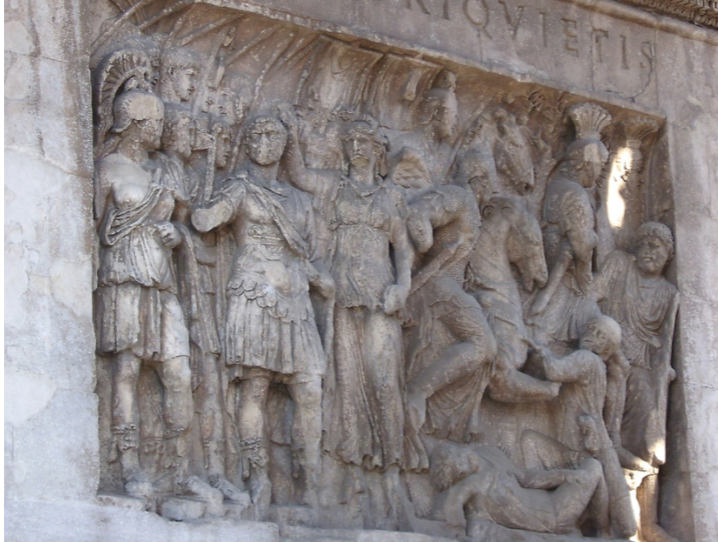
Identify and Analyze
Trajan crowned by Victory, Great Trajanic Frieze, from the Forum of Trajan
within the heart of the Trajan Forum
Meant to commemorate the amount of work that went into the forum
height of the column was the same as the amount of dirt that was taken away from the area during construction
Trajan’s Victory in Dacia
Trajan’s and Plotina’s ashes in base
not originally meant to be a tomb
column was so famous that Hadrian and the senate voting on putting them there
3 Parts
Base
door inside to stairs that lead up to the top
Column
stairs inside
decked out with relief sculpture
separate drums attached together
if broken, the whole column wouldn’t be garbage, they could just replace a single part
Top
statue of Trajan on horseback
now gone
Modern adaptation
statue of Saint Peter placed in 16th century
part of the column was partly buried for a while but it was always visible
Relief Sculpture
Adventus Scene
Trajan returning from the battle
Crowned by Victory
Virtus + Honos personifications with them
male virture and honour
Spoilia
content taken from one context and put into another
this scene was repurposed and put into the Arch of Constantine
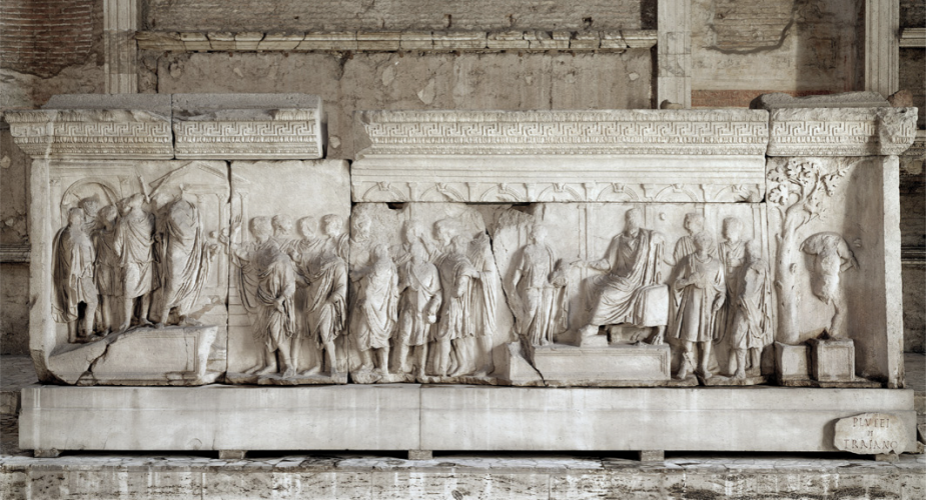
Identify and Analyze
Emperor addressing a crowd in the Forum Romanum, Anaglypha Traiani
The Trajan and Hadrian Period
98 CE - 138 CE
Success of Conquering of Dacia
many riches came into Roman economy
Trajan made public announcement that all Roman citizens were forgiven of their debt
would hand out bread to the citizens for free
Trajan seated on Dias
giving of bread to the people
curule chair
senior magistrates (consuls, praetors, censors, etc) and all those with imperium were entitled to sit
glorifying the emperor as leader and doing things for the people
Forum
how do we know it’s in the Forum?
imagery of Marsyas to the right
myth of Marsyas the Satyr who was so good at playing pipes, he claimed he was better than Apollo
they have a competition and Marsyus loses
Apollo ordered him to my flayed alive while hung from a fig tree - famous Greek statue depicting the moment before he is flayed that was put up in the Roman Forum
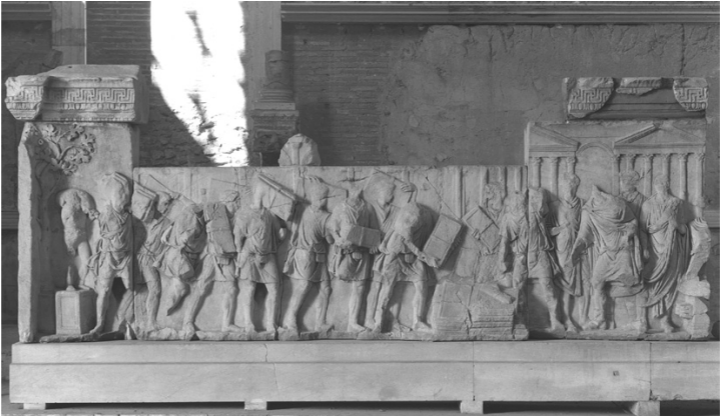
Identify and Analyze
Burning of debt records in the Forum Romanum, Anaglypha Traiani
The Trajan and Hadrian Period
98 CE - 138 CE
Success of Conquering of Dacia
many riches came into Roman economy
Trajan made public announcement that all Roman citizens were forgiven of their debt
Trajan to Left
head lost
speaking to crowd - adlocutio pose
Roman soldiers next to him carrying debt/tax records to a fire to be burnt
glorifying the emperor as leader and doing things for the people
Roman Forum
how do we know?
imagery of Marsyas to the left
myth of Marsyas the Satyr who was so good at playing pipes, he claimed he was better than Apollo
they have a competition and Marsyus loses
Apollo ordered him to my flayed alive - famous Greek statue depicting the moment before he is flayed that was put up in the Roman Forum
imagery of forum buildings
Basilica Julia
Temple of Saturn
Temple of Vespasian
Temple of Titus
Temple of Concordia
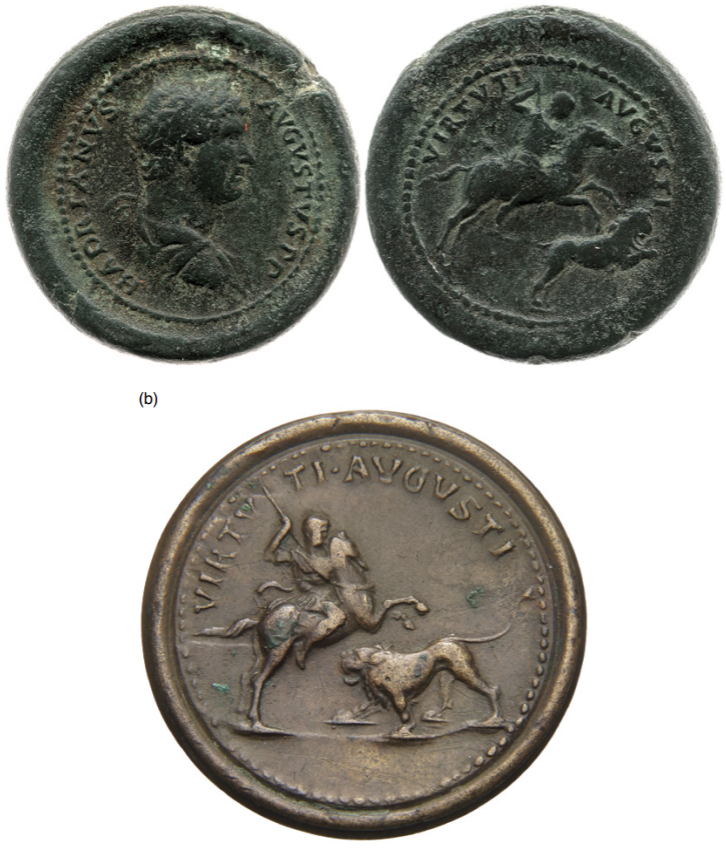
Identify and Analyze
Medallions of the virtuti Augusti, the manliness of the emperor Hadrian
The Trajan and Hadrian Period
98 CE - 138 CE
love of Greek
adopted some images
Image of the Hunt
manly virtue - Virtus
hunt as a substitute for war when there were none to fight in
Hadrian Hunting Lion
Virtuti Augsti - Virtus of the emperor
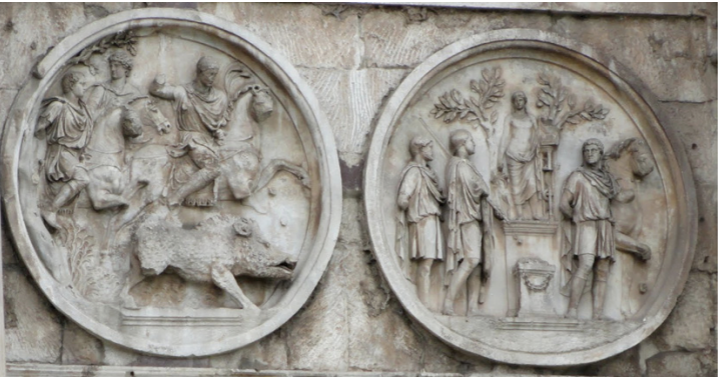
Identify and Analyze
Tondi of Hadrian from the Arch of Constantine, Rome
The Trajan and Hadrian Period
98 CE - 138 CE
Tondi
round reliefs panels
based on a series of medallions (seen above)
Spoilia
reused in the Arch of Constantine
meant to show virtues of the Emperor
boar hunt - manliness
image of the hunt from Greek culture
hunting as an alternative to war when there was none to fight in
Possibly Antinous in background
dressed as another god
Sacrifice to Apollo, Hercules, Silvanus, and Diana
Dynasty
as a theme
Hadrian’s court and possible successors of the throne in background
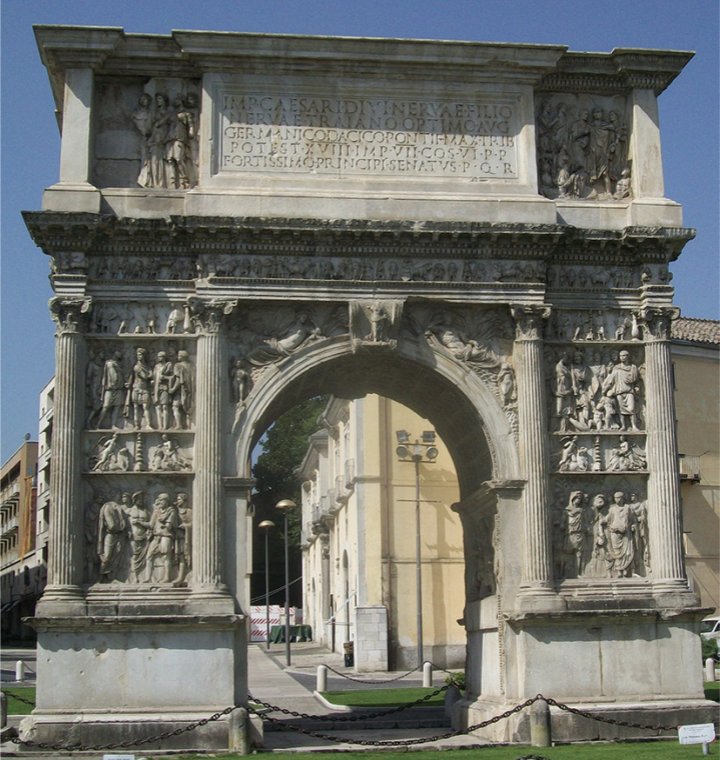
Identify and Analyze
Arch of Trajan, Beneventum
The Trajan and Hadrian Period
98 CE - 138 CE
finished under Hadrian
largest set of ideological images from any single monument in the Roman world
Main Body
eight large relief panels
Attic
four large relief panels
two on each side
Passage
personified victory figures
Spandrels
roughly triangular space between the curve of an arch and the surrounding molding
usually filled with victories when on triumph arches
Relief Sculpture
generic, none historical
unspecific battles shown
“I beat the Daitians” instead of “here is the specific leader that I defeated during this part of our campaign”
covered in sculpture
later on - arches become fully covered in sculpture rather than only certain sections
Exterior
memorializing Trajan’s major accomplishments
military campaigns
founding of colonies
creating his alimentary scheme
establishing harbours
reorganizing the army
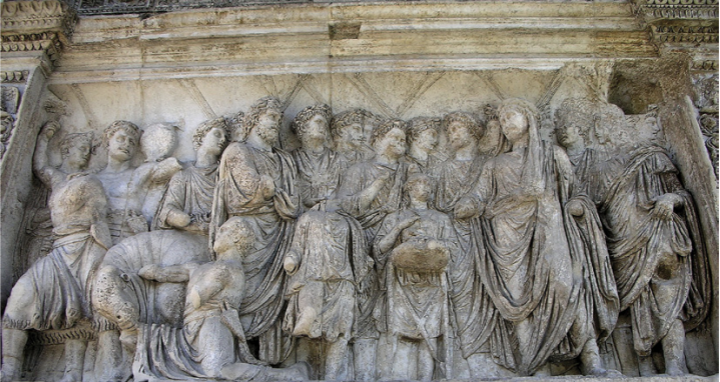
Identify and Analyze
Sacrifice relief panel, Arch of Trajan, Beneventum
The Trajan and Hadrian Period
98 CE - 138 CE
Sacrifical bull
Pious - honours the gods
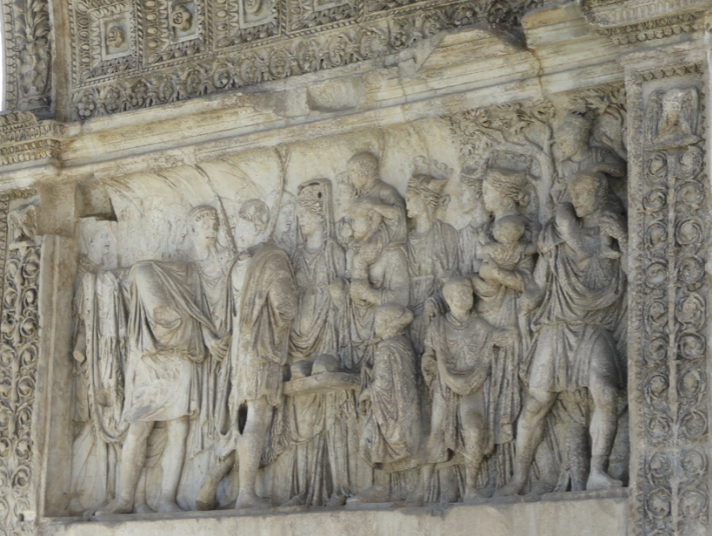
Identify and Analyze
Alimenta relief panel, Arch of Trajan, Beneventum
The Trajan and Hadrian Period
98 CE - 138 CE
3D lumps - loaves of bread being given out
Togas
running drill now used in textiles, not only hair anymore
alimentary payments to widows and orphans
Crenellated Crowns vs. Contemporary Headdresses
crowns on the women
showing they are not individuals but personifications of communities

Identify and Analyze
Keystone image of Victory crowning Trajan, Arch of Trajan, Beneventum, Italy
The Trajan and Hadrian Period
Trajan being crowned by Victory
still alive, so he is not yet being carried off to the heavens to be with the gods
like Titus on his eagle
not yet completely deified
Border
piled captive arms and armour
also seen on the based of the Column of Trajan
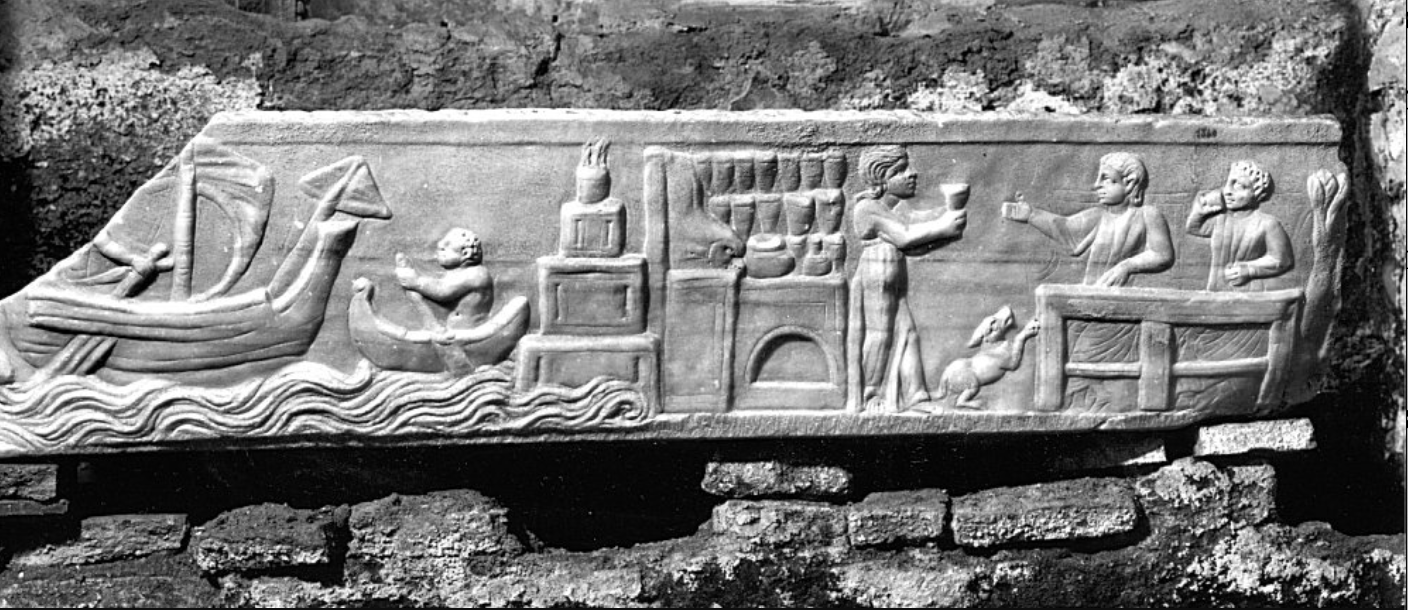
Identify and Analyze
Relief portraying the interior of a tavern, from Isola Sacra necropolis, Ostia
The Trajan and Hadrian Period
98 CE - 138 CE
Tomb Relief
Ostia Necropolis
not elite- would have been reclining while drinking if they were
a woman serving the drinks
focus on the woman in this tomb rather than the male figures
maybe the owner of the establihsment>
tells us more about women economics + their lifestyles within Rome
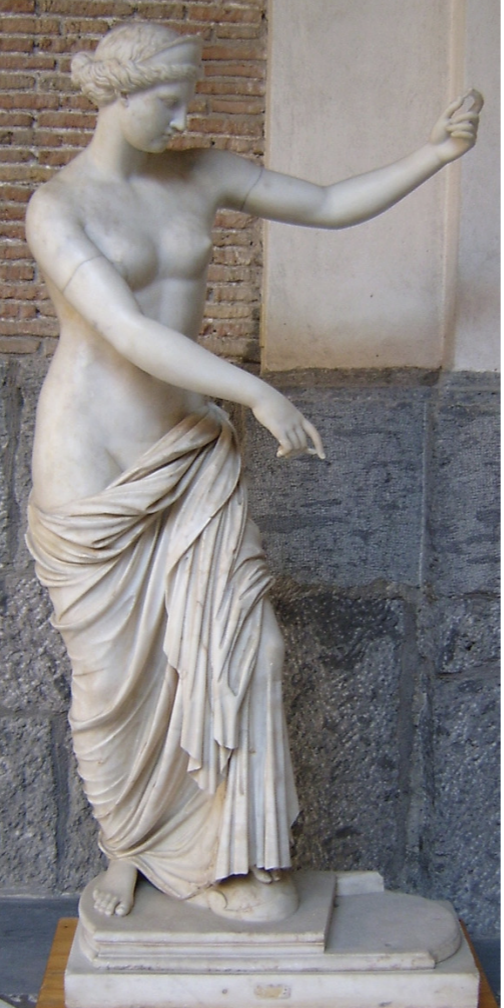
Identify and Analyze
Venus statue from the facade of the amphitheater at Capua, Italy, Hadrianic
The Trajan and Hadrian Period
98 CE - 138 CE
miniature replica of a statue that would have been on the colosseum
is this reflective od the decor there?
gives us insight
Statues on Colosseum
different god statues on colosseum represented different aspects of the events that happened within
Amphitheatre at Capua
a smaller copy of the colosseum
installed decoration under Hadrian
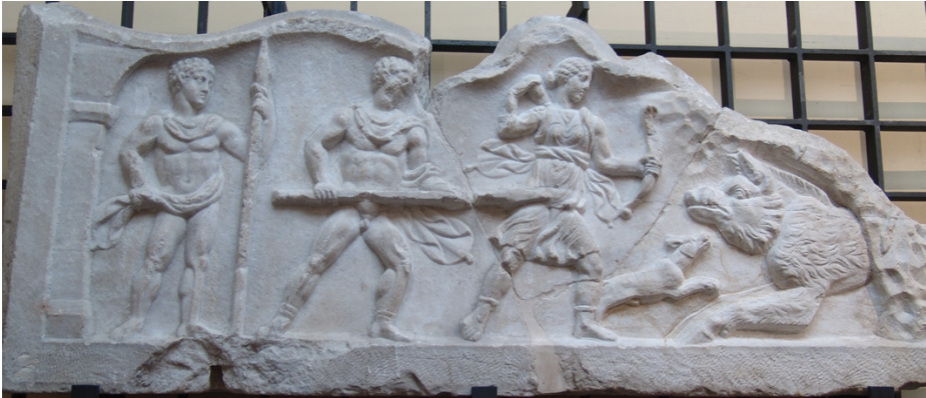
Identify and Analyze
Calydonian Boar Hunt relief panel from the amphitheater at Capua, Italy
The Trajan and Hadrian Period
98 CE - 138 CE
myth
a monstrous boar is sent by Artemis to plague the land of Calydon because King Oeneus failed to offer her a sacrifice.
Meleager (Oeneus's son) and Atalanta hunt the beast
hunt ends with Meleager killing the boar, but not without a tragic aftermath involving a quarrel over the spoils and ultimately Meleager's death
Relief
Atlanta’s leading with her bow, Meleager behind with a spear on the left
3rd hunter on far left, showing it’s in an arena and not in the wild
reminiscent of what’s going on in an amphitheatre
Hadrian’s presentation of the image of the Hunt being equated to manly virtue
one of best preserved panels

Identify and Analyze
Relief of Antinous as the god Silvanus, from Lanuvium
The Trajan and Hadrian Period
98 CE - 138 CE
see Serapus Tempel to fill in info on Antinous here
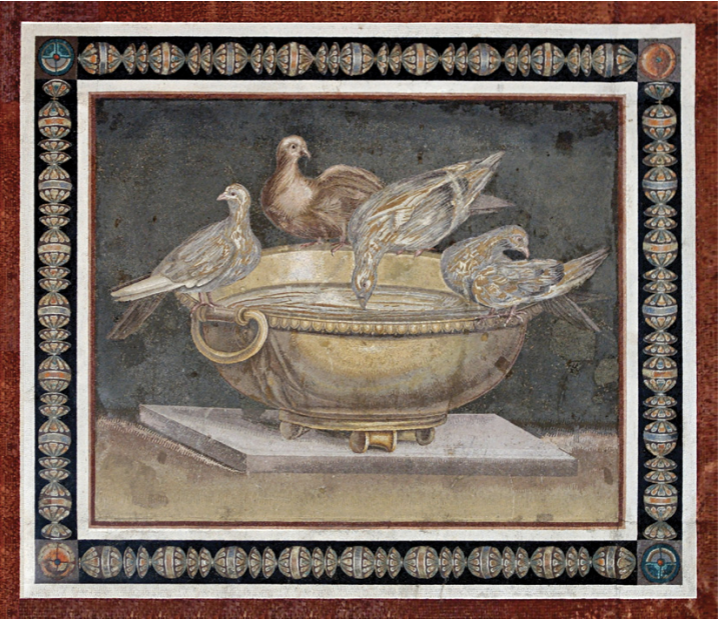
Identify and Analyze
Dove mosaic from the Villa of Hadrian, Tivoli, Hadrianic
The Trajan and Hadrian Period
98 CE - 138 CE
Villa of Hadrian
Highest quality
exact copy of a 200BCE painting of only named mosaicist in antiquity
Sosus of Pergamon
mosaicist
Opus Vermiculatum
“worm work”
individual tesserae so small you can curve a line very easily
Tromp l’oeil that its so lifelike even real birds would try to drink from the bowl
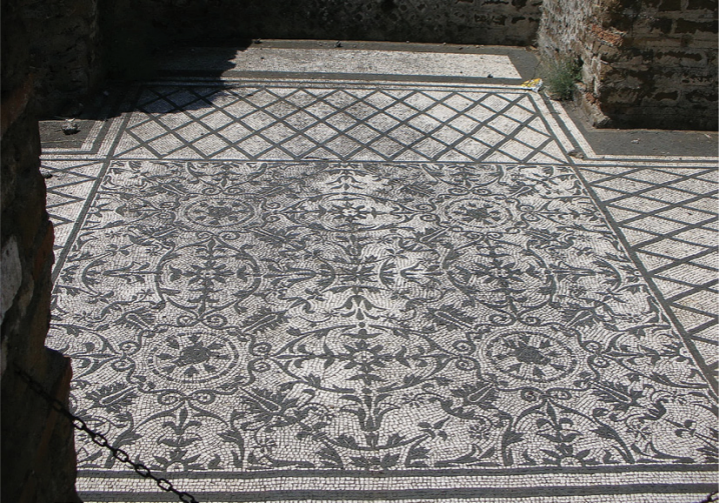
Identify and Analyze
Black and white mosaic from the Villa of Hadrian, Tivoli, Hadrianic